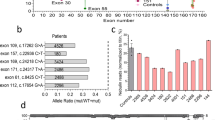Abstract
DYTCA is a syndrome that is characterized by predominant dystonia and mild cerebellar ataxia. We examined two affected siblings with healthy, consanguineous, Turkish parents. Both patients presented with a combination of childhood-onset cerebellar ataxia, dystonia, and sensory axonal neuropathy. In the brother, dystonic features were most pronounced in the legs, while his sister developed torticollis. Routine diagnostic investigations excluded known genetic causes. Biochemical analyses revealed a mitochondrial respiratory chain complex IV and a coenzyme Q10 deficiency in a muscle biopsy. By exome sequencing, we identified a homozygous missense mutation (c.154A >C; p.Thr52Pro) in both patients in exon 2 of the COX20 (FAM36A) gene, which encodes a complex IV assembly factor. This variant was confirmed by Sanger sequencing, was heterozygous in both parents, and was absent from 427 healthy controls. The exact same mutation was recently reported in a patient with ataxia and muscle hypotonia. Among 128 early-onset dystonia and/or ataxia patients, we did not detect any other patient with a COX20 mutation. cDNA sequencing and semi-quantitative analysis were performed in fibroblasts from one of our homozygous mutation carriers and six controls. In addition to the exchange of an amino acid, the mutation led to a shift in splicing. In conclusion, we extend the phenotypic spectrum of a recently identified mutation in COX20 to a recessively inherited, early-onset dystonia-ataxia syndrome that is characterized by reduced complex IV activity. Further, we confirm a pathogenic role of this mutation in cerebellar ataxia, but this mutation seems to be a rather rare cause.



Similar content being viewed by others
References
Agier V, Oliviero P, Laine J, L’Hermitte-Stead C, Girard S, Fillaut S, Jardel C, Bouillaud F, Bulteau AL, Lombes A (2012) Defective mitochondrial fusion, altered respiratory function, and distorted cristae structure in skin fibroblasts with heterozygous OPA1 mutations. Biochim Biophys Acta 1822:1570–1580
Arif B, Kumar K, Seibler P, Franke F, Fatima A, Winkler S, Nürnberg G, Thiele H, Nürnberg P, Zeeshan Jamil A et al (2013) Exome sequencing reveals a novel OPA3 mutation: An example of “reverse phenotyping”. JAMA Neurol 70(6):783–787
DiMauro S, Tanji K, Schon EA (2012) The many clinical faces of cytochrome c oxidase deficiency. Adv Exp Med Biol 748:341–357
Fischer JC, Ruitenbeek W, Gabreels FJ, Janssen AJ, Renier WO, Sengers RC, Stadhouders AM, ter Laak HJ, Trijbels JM, Veerkamp JH (1986) A mitochondrial encephalomyopathy: the first case with an established defect at the level of coenzyme Q. Eur J Pediatr 144:441–444
Gouider-Khouja N, Kraoua I, Benrhouma H, Fraj N, Rouissi A (2010) Movement disorders in neuro-metabolic diseases. Eur J Paediatr Neurol 14:304–307
Grünewald A, Voges L, Rakovic A, Kasten M, Vandebona H, Hemmelmann C, Lohmann K, Orolicki S, Ramirez A, Schapira AH et al (2010) Mutant Parkin impairs mitochondrial function and morphology in human fibroblasts. PLoS ONE 5:e12962
Koopman WJ, Visch HJ, Verkaart S, van den Heuvel LW, Smeitink JA, Willems PH (2005) Mitochondrial network complexity and pathological decrease in complex I activity are tightly correlated in isolated human complex I deficiency. Am J Physiol Cell Physiol 289:C881–C890
Kuoppamaki M, Giunti P, Quinn N, Wood NW, Bhatia KP (2003) Slowly progressive cerebellar ataxia and cervical dystonia: clinical presentation of a new form of spinocerebellar ataxia? Mov Disord 18:200–206
Le Ber I, Clot F, Vercueil L, Camuzat A, Viemont M, Benamar N, De Liege P, Ouvrard-Hernandez AM, Pollak P, Stevanin G et al (2006) Predominant dystonia with marked cerebellar atrophy: a rare phenotype in familial dystonia. Neurology 67:1769–1773
LeDoux MS (2012) The genetics of dystonia. Adv Genet 79:35–85
Rolland SG, Motori E, Memar N, Hench J, Frank S, Winklhofer KF, Conradt B (2013) Impaired complex IV activity in response to loss of LRPPRC function can be compensated by mitochondrial hyperfusion. Proc Natl Acad Sci USA 110:E2967–E2976
Szklarczyk R, Wanschers BF, Nijtmans LG, Rodenburg RJ, Zschocke J, Dikow N, van den Brand MA, Hendriks-Franssen MG, Gilissen C, Veltman JA et al (2013) A mutation in the FAM36A gene, the human ortholog of COX20, impairs cytochrome c oxidase assembly and is associated with ataxia and muscle hypotonia. Hum Mol Genet 22:656–667
Talelli P, Hoffland BS, Schneider SA, Edwards MJ, Bhatia KP, van de Warrenburg BP, Rothwell JC (2011) A distinctive pattern of cortical excitability in patients with the syndrome of dystonia and cerebellar ataxia. Clin Neurophysiol 122:1816–1819
Thusberg J, Olatubosun A, Vihinen M (2011) Performance of mutation pathogenicity prediction methods on missense variants. Hum Mutat 32:358–368
van de Warrenburg BP, Giunti P, Schneider SA, Quinn NP, Wood NW, Bhatia KP (2007) The syndrome of (predominantly cervical) dystonia and cerebellar ataxia: new cases indicate a distinct but heterogeneous entity. J Neurol Neurosurg Psychiatry 78:774–775
van Gaalen J, Giunti P, van de Warrenburg BP (2011) Movement disorders in spinocerebellar ataxias. Mov Disord 26:792–800
Wallace DC, Murdock DG (1999) Mitochondria and dystonia: the movement disorder connection? Proc Natl Acad Sci USA 96:1817–1819
Acknowledgments
This work was supported by a grant from the German Ministry of Education and Research (BMBF, Bonn, Germany) to the German network for mitochondrial disorders (mitoNET, 01GM1113A, to TK), a Grant from the Hermann and Lilly Schilling Foundation (to CK) and intramural funding from the University of Luebeck “Schwerpunktprogramm: Medizinische Genetik - Von seltenen Varianten zur Krankheitsentstehung” (to KL, PS, CZ, CK).
Conflicts of interest
The authors declare that they have no conflict of interest.
Author information
Authors and Affiliations
Corresponding author
Additional information
S. Doss and K. Lohmann contributed equally to this work.
Electronic supplementary material
Below is the link to the electronic supplementary material.
Rights and permissions
About this article
Cite this article
Doss, S., Lohmann, K., Seibler, P. et al. Recessive dystonia-ataxia syndrome in a Turkish family caused by a COX20 (FAM36A) mutation. J Neurol 261, 207–212 (2014). https://doi.org/10.1007/s00415-013-7177-7
Received:
Revised:
Accepted:
Published:
Issue Date:
DOI: https://doi.org/10.1007/s00415-013-7177-7




